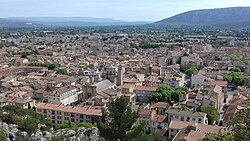Top Qs
Timeline
Chat
Perspective
Cavaillon
Commune in Provence-Alpes-Côte d'Azur, France From Wikipedia, the free encyclopedia
Remove ads
Cavaillon (French pronunciation: [kavajɔ̃] ⓘ; Occitan: Cavalhon) is a commune in the Vaucluse department in the Provence-Alpes-Côte d'Azur region of Southeastern France.[3] It is situated in the Durance Valley, at the foot of the Luberon mountains.
Remove ads
History
Cavaillon was already a city in the Gallo-Roman period, and has several minor relics from that era, including a 1st century triumphal arch.[4] Other minor relics of the Roman period have been found to the south of the town, on the site of the ancient Cabellio.[5] It was the seat of the bishops of Cavaillon from the 4th century[6] until the French Revolution.[5] Saint Veran was bishop here in the 6th century,[citation needed] and the 12th-century cathedral is dedicated to him. In the Middle Ages Cavaillon was part of the Comtat Venaissin.[5]
Remove ads
Geography
Cavaillon is part of the Regional and Natural Park of Luberon (parc naturel régional du Luberon) in the French Department of Vaucluse.
The Calavon, a tributary of the Durance locally called Coulon, flows westward through the middle of the commune.
The Durance forms the commune's south-western border.
Population
Economy
Cavaillon is famous for its melons, as well as other early fruits and vegetables.[5]
Famous people
- Saint César de Bus
- Castil-Blaze, French musicologist, Music critic and Composer
- Luc Bulot, French palaeontologist
- Pierre Salinger, press secretary to U.S. President John F. Kennedy, U.S. Senator from California, Paris bureau chief for ABC News
Sights
- the 11th-13th century Cavaillon Cathedral[6]
- Colline Saint-Jacques, with chapel
- Roman triumphal arch[4]
Twin towns
- Cavaillon has been twinned with Weinheim, Germany, since 1958 and Langhirano, Italy, since 2001.
Climate
Remove ads
See also
References
External links
Wikiwand - on
Seamless Wikipedia browsing. On steroids.
Remove ads





